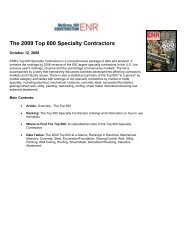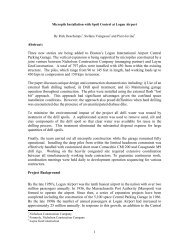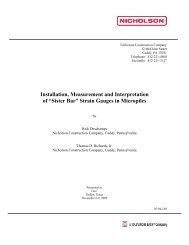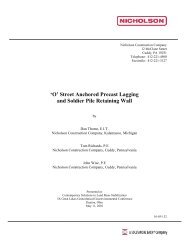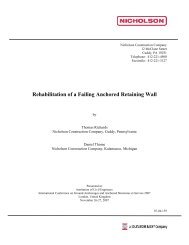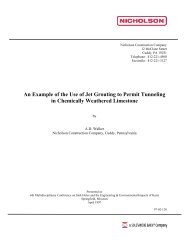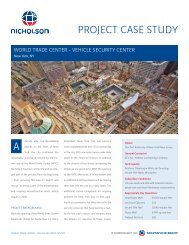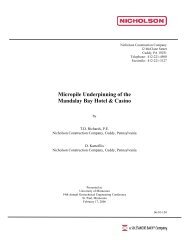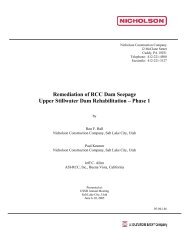Post-Tensioned Stabilization of Roy Inks Dam - Nicholson ...
Post-Tensioned Stabilization of Roy Inks Dam - Nicholson ...
Post-Tensioned Stabilization of Roy Inks Dam - Nicholson ...
You also want an ePaper? Increase the reach of your titles
YUMPU automatically turns print PDFs into web optimized ePapers that Google loves.
POST-TENSIONED STABILIZATION OF ROY INKS DAMJohn S. Wolfhope, P.E.Project ManagerFreese and Nichols, Inc.jsw@freese.comJerome W. Scanlon, P.E.AssociateFreese and Nichols, Inc.jws@freese.comGregor ForbesProgram ManagerLower Colorado River Authoritygforbes@lcra.orgRoger A. BaldwinProject Executive<strong>Nicholson</strong> Constructionrbaldwin@nicholson-rodio.comABSTRACT<strong>Roy</strong> <strong>Inks</strong> <strong>Dam</strong> (<strong>Inks</strong> <strong>Dam</strong>) is a high hazard, concrete gravity dam located on theColorado River near Burnet, Texas. The dam, constructed from 1936 to 1938, isowned and operated by the Lower Colorado River Authority (LCRA). During theLCRA <strong>Dam</strong> Modernization Program, the extreme flood events were reevaluatedfor the Highland Lakes <strong>Dam</strong>s. As a result, <strong>Inks</strong> <strong>Dam</strong> was found to be subject to amore severe loading condition than was considered in the original design. Thedam’s stability was analyzed under the new loading conditions and stabilizationimprovements were designed to protect the 880 feet long, uncontrolled, ogeeshapedspillway.Construction improvements to the dam included removal <strong>of</strong> the top lift <strong>of</strong> thespillway, construction <strong>of</strong> a reinforced concrete stressing beam, installation <strong>of</strong>forty-six 24-strand (1000 kip) post-tensioned anchors, and reconstruction <strong>of</strong> thecrest <strong>of</strong> the dam. The project also included an 18-inch pipeline penetrationthrough the dam to relocate an existing USFWS Fish Hatchery water supply line.This paper provides an overview <strong>of</strong> the challenges presented to the design teamdue to the unique nature <strong>of</strong> this project and the existing condition <strong>of</strong> the structure.It also presents a discussion <strong>of</strong> the construction and addresses how lessonslearned from previous post-tensioned spillway anchoring projects wereincorporated.



